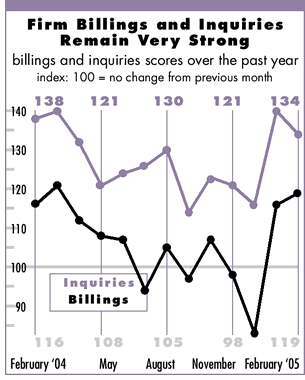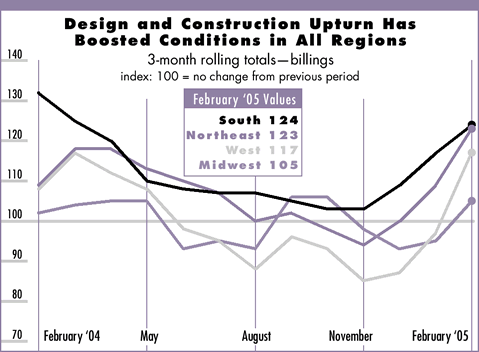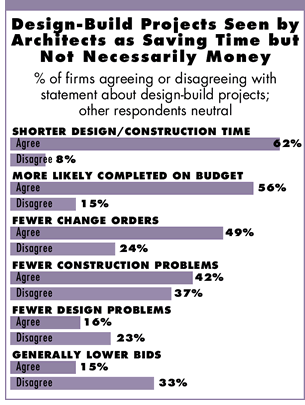

2005 Off to a Great
Start for Firms
Design-build becoming popular project delivery
alternative

by Kermit Baker,
PhD, Hon. AIA
Chief Economist
 U.S.
architecture firms reported another strong upturn in business conditions
in February, coming on top of a surprisingly strong January. Fully a
third of firms indicated that February billings exceeded January levels
by 5 percent or more, while only 14 percent noted a decline. Larger firms
were particularly enthusiastic about business conditions, with a third
reporting gains and only 4 percent indicating declines.
U.S.
architecture firms reported another strong upturn in business conditions
in February, coming on top of a surprisingly strong January. Fully a
third of firms indicated that February billings exceeded January levels
by 5 percent or more, while only 14 percent noted a decline. Larger firms
were particularly enthusiastic about business conditions, with a third
reporting gains and only 4 percent indicating declines.
Commercial/industrial architecture firms reported the sharpest gains in billings. These firms also indicated strong growth in inquiries for new projects, so the recent upturn is likely to be sustained over the next several months in these construction sectors. The upturn in design activity has been felt by firms in all regions of the country. Firms in the South report the strongest growth in billings, as well as in inquiries for new work, followed closely by firms in the Northeast.
National
economy improving
The national economy continues to show improvement. Particularly noteworthy
is the recent report on housing construction. Housing starts totaled
almost 2.2 million units in February when seasonally adjusted and
annualized, which is the strongest housing construction number since
1978. Housing, though a key driver of the economy in recent years,
isn’t the
only sector breezing along at present. Consumer spending remains
strong, as retail sales are growing at a 5.5 percent pace through
the first two months of the year.

Economy
moving the right way
Payrolls increased nationally by 262,000 in February, a pace that would
generate more than three million new jobs this year. Construction played
a strong role in this gain, with this sector adding a net 30,000 jobs
during the month. Further improvement in the economy seems likely,
as the leading economic index developed by the Economic Cycle Research
Institute advanced nicely in February and has increased three of the
past four months.
 Though popular, design-build has some detractors
Though popular, design-build has some detractors
In recent years, design-build projects have grown in popularity for many
building categories. Well over half (57 percent) of the AIA Work-on-the-Boards
panel members report that their firms have worked on a least one design-build
project over the past two years. Two thirds of our panel members feel
that design-build projects will account for a larger share of total
construction activity 10 years from now than they do today. However,
only a quarter of firms in this panel agree with the statement that
design-build represents a superior project-delivery method from the
architect’s perspective; 42 percent disagree with that statement,
and 33 percent are neutral.
A majority of firms feel that design-build projects have a shorter design and construction time and an increased likelihood that projects will be completed within budget, and almost half feel that these projects generally have fewer change orders. At the other extreme, few members of our panel feel that that the design-build process generally produced lower bids or generates fewer problems in the design phase. A common comment by panelists was that although design-build offers some advantages relative to traditional design/bid/build, many of them accrue to the contractor rather than the architect.
Copyright 2005 The American Institute of Architects.
All rights reserved. Home Page ![]()
![]()
 |
||
| This month, Work-on-the-Boards survey participants are saying: • Lots of small residential additions and renovations. Some small
commercial work. • Miami is booming! Can’t get subs to bid. It’s
their market. • A very strong demand for staff in the San Francisco Bay
Area leads me to believe that market conditions are improving dramatically. • Busy. Work looks good into the future.
|
||